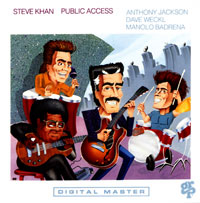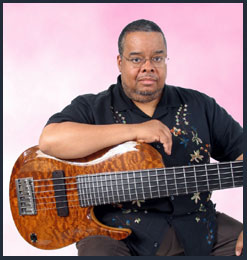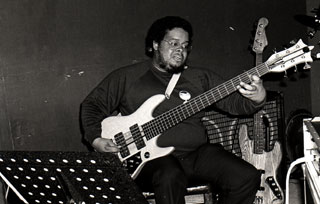

|
Soundclip:
|
| See Steve's Hand-Written Lead
Sheet |
|
Steve
Khan's
lead
sheet:  I suppose it is of some interest that, when we have toured together, in a trio context, since the recording, Anthony always asks me if we could play this piece. To this day, we still haven't performed it live. I suppose it is of some interest that, when we have toured together, in a trio context, since the recording, Anthony always asks me if we could play this piece. To this day, we still haven't performed it live.I don't know why it is so, but, writing a ballad always seems to come easier to me. Without so much struggle and inner torment. Without question I had the [I] section first, and, as it always is, this sets the mood for everything that is to follow. I recall that, during the composing process, the melody just seemed to flow and the harmonization of it became obvious. If you isolate the guitar voicings at [I], it can seem like virtually any bass note might work. But, after some trial and error on my part, I found a particular movement that made the most sense to me. I have decided to label the chords in a way which best communicates what is happening. In bar 3 of each 4-bar phrase, I have labeled that first chord as Bbm7(sus) even though I have spelled the actual notes with sharps because of where this chord is headed. I also believe that, in the end, it looks less obtuse to see a movement from Bbm7(sus) to Dmaj9(#4) rather than from A#m7(sus). I just didn't want anyone to be confused by the labeling of the chord. Prior to our rehearsals for the recording, I had heard this tune as a relatively standard "Jazz ballad" to be played with brushes, lots of space, quiet and delicate. But, what developed turned out to be something far, far different. Once Anthony and Dave Weckl got ahold of it, it was transformed. At times, to these ears, it almost resembles some kind of anthemic "Rock" ballad style. I'm pretty certain that I never got to hear brushes on this one! And, if you follow along with Anthony's rhythmic approach, you can see, and feel the shuffling sense provided by all the triplet groupings and subdivisions. When you add into this Anthony's usage of one of his signature sounds: the pick and the flanger, the drama, provided by this unique combination of musical and sonic elements just propels the section, and the piece, in a powerful direction. After the first 4-bars establishes the "mood", with each successive statement, Anthony takes more liberties, but what is worth studying, and learning from, is his usage of chromatic approach tones to bars 1 and 3. And, it is not just the notes he uses, look at the rhythmic placement. It is precise, and full of force and power!  As we arrive at the statement of the melody at [A], once again, Anthony returns to a more spare and sparse approach, but as the tune unfolds and the harmony carries with it, its own intensity, he adds some very special touches. Beginning at bar 7, he introduces repeated notes, one octave above the principal bass note. These notes are almost always placed off of 'one.' There is also his most shrewd usage of the open low 'B'-string afforded by his contrabass guitar. In this first melody statement you see that note appear in bars: 3, 11, and 17. You will also find notes that are below the usual open low 'E'-string, such as: Eb in bar 8 and 13, and Db in bar 15. Of course, he has already used his low 'D' in bars 3-4 of the [I] sections. One thing which is always true about a ballad, especially on "Jazz"-oriented recording, they take a long time! Sometimes, just the full statement of the melody can take nearly 3-4 minutes. So, knowing that one must try to be economical in laying out a solo format. Of course, the coming of the "CD Age" has expanded what is possible by, at times, nearly 35+ minutes. So this alone has helped us all somewhat. The solo section, which is made up of [B] and [B2] in very much the same harmonic format as the [A] sections, features more spectacular interplay from Anthony and Dave. But, one can never underestimate what Manolo Badrena brings to it all. He is a master of moods and textures, and his approach enables me to play less. At least that's my sense of it all. Over the years, his percussion 'rig' has gone through increases and decreases, depending upon his music-making proclivities at any particular time. On the "PUBLIC ACCESS" recording, he came with his full compliment of natural sounds, and electronic options for which to enhance those sounds. What you hear was almost totally controlled by Manolo, and not created by 'magical' engineering effects after the fact. As we arrive at [B2], the piece takes on the form of 'double-time swing' which Anthony and Dave bring to a graceful halt on the resolution to the Bmaj7(9) chord, just two bars before [I2]. In a solo section like this one, I think that you have to let go of any preconceived notions you might have held before the performance, and just go with the flow. If you asked for what you were looking for in a clear manner at the rehearsals, and things went in another direction, you could "beat a dead horse" about it, or just let go!!! For me, it has been a great life lesson to just learn to let it go, and to try and find a new path within what is there. One could also do many, many takes, but the results will probably be most similar because people don't change their approaches in the course of an hour. So, this was probably our only take of "Silent Screen."  At [I2], which is only 8 bars long this time, there are two fantastic little moments from Anthony which are worth your attention. In bar 4, his octave walk-up to the 'B'-natural is incredible, and not just for the choice of notes. It is so great because of his sense of rhythmic command, and the self-confidence in just where they are placed. Then, in bar 6, over the E/G# sonority, he adds in the #4[spelled here as Bb]. This is a wondrous touch, because this kind of color-tone has not been offered before during the piece, and so, it really stands out. The final statement of [A] brings everything to a lustrous conclusion, because of all that has taken place during the solo section. This time, after bar 16, we take a Coda which leads us to an ending. The Coda is played with a gradual 'ritard' as the melodic harmony ascends. This is a nice contrast of those two elements. From the guitar perspective, after the last chord has been struck, I am lightly brushing over it with the fleshy part of my index finger. This is all done as Anthony's cavernous low 'B'-string sounds out. The title for this piece came from Manolo's fascination with photos of actress Theda Bara. I remember, when I was little, that actors like Charlie Chaplin and Buster Keaton, just to name two, were referred to as "silent screen" stars. And so, Theda Bara would fall into that category too. Hence the title, "Silent Screen." It is of no more significance than that.
[Photo Portrait of Anthony Jackson by: Vincent Fodera
as it appeared in the October '05 "MODERN DRUMMER"] |